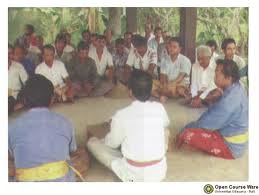Monday, October 3, 2011
Subak | Cultures of Denpasar
Subak is an indigenous people in Bali who have the characteristics of socio-agrarian-religious, which is a farmers' association that manages the irrigation water in paddy fields. Topography and environmental conditions of rivers in Bali are steep causing the water source for a complex of rice farmers are generally far enough. Sometimes in order to be able to channel the water into a complex of rice fields, they should make a tunnel through the rocky hills. These conditions cause the farmers to collect themselves and establish Bali Subak organization.
Subak led by a coordinating Subak Kelian or Pekaseh based water management order (awig-awig) are arranged in an egalitarian. When irrigation is running fine, they enjoy water adequacy together. Conversely, when the irrigation water is very small, they will have limited water together. Planting schedules are strictly implemented. Planting time is set in a certain period. Generally, set in the span of two weeks. Farmers in violation will be penalized.
To obtain optimal use of water and evenly, excess water can be discharged through the drainage channels are available at any complex / block of fields owned by farmers. Meanwhile, to overcome the water shortage problem that is not unexpected, they do so in ways such as:
* Mutual borrowing between members of the Subak irrigation water in one Subak, or inter-related subak whose system
* Do pelampias system, ie a policy to provide additional water for paddy fields located more downstream. Additional amount of water is determined by mutual agreement,
* Perform reduction portion of the water system should be placed on a block / complex of certain farmers' fields, where rice has been a water leak from a certain region around
If the irrigation water discharge is small, farmers Subak members are not allowed into the fields at night, water regulation submitted to the board Subak. Thus the distribution of water runs fairly.
Each has Subak temple called Pura Uluncarik or Pura Bedugul specially built by farmers to worship God in its manifestation as the goddess of prosperity and fertility, Dewi Sri.
The green revolution has led to changes in irrigation systems, with the new rice varieties and new methods, farmers must plant rice as often as possible, ignoring the needs of other farmers. This is very different from the Subak system, in which the needs of all farmers are preferred.
The method is new in the green revolution produced abundant results initially, but then followed with constraints such as shortage of water, pests and pollution due to pesticides both in soil and in water. Finally it was found that rice irrigation systems have traditionally been very effective for overcoming this obstacle.
Scientists who examined the Subak include Clifford Geertz, and J. Stephen Lansing. In 1987 Lansing working with Balinese farmers to develop computer models Subak irrigation system. With it he proved the effectiveness of the Subak and the importance of this system.
Subscribe to:
Post Comments (Atom)
Cultures of Denpasar Copyright © 2011 | Powered by Blogger

0 comments:
Post a Comment